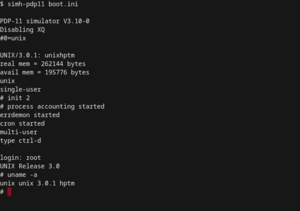Unix facts for kids
 |
|

Unix System III running on a PDP-11 simulator
|
|
| Company / developer | Ken Thompson, Dennis Ritchie, Brian Kernighan, Douglas McIlroy, and Joe Ossanna at Bell Labs |
|---|---|
| Programmed in | C and assembly language |
| OS family | Unix |
| Source model | Historically proprietary software, while some Unix projects (including BSD family and illumos) are open-source |
| Initial release | Development started in 1969 First manual published internally in November 1971 Announced outside Bell Labs in October 1973 |
| Available language(s) | English |
| Kernel type | Varies; monolithic, microkernel, hybrid |
| Influenced by | CTSS, Multics |
| Default user interface | Command-line interface and Graphical (Wayland and X Window System; Android SurfaceFlinger; macOS Quartz) |
| License | Varies; some versions are proprietary, others are free/open-source software |
UNIX is a computer operating system. It was first developed in 1969 at Bell Labs. Ken Thompson, Dennis Ritchie, Douglas McIlroy, and others created it. They used assembly language to write it. In 1972, the Unix code was rewritten with the new C programming language. The Unix operating system is a multiuser and multiprocessing system. This means it can run several application programs at the same time, for more than one user at the same time. It also is able to operate well in a network of computers. Computer security is also important in Unix, because many people can have access to it, both by using a computer directly or over a network.
Many ideas in Unix were new. Other operating systems copied them. Today, there are many operating systems that have some of the ideas of Unix in them. For this reason, some people talk about a "Unix philosophy" of doing things. Linux is one of these systems with many of the Unix ideas in it. Linux does not use code from UNIX. Linux only shares some of the ideas and the names of commands. So, Linux is not a UNIX operating system. Instead it is called "Unix-like".
There can be many different users in a Unix and Unix-like operating system. Most of them have a personal area where they can put things. This is called a user account.
One way of using a Unix system is with the command line interface. Users run commands and programs by typing text characters. This takes time to learn, but it is a very powerful and flexible way of working. It is still used by most Unix administrators. These commands are run in a shell, which can change slightly between one system and another.
A graphical user interface (GUI) is the other method. The X Window System is a very common GUI for Unix systems. The X Window System is only a shell of a graphical interface. It has many protocols. The X Window System itself does not let the user to move and resize windows. Users need a window manager or desktop manager to do that.
Some of the popular desktop and window managers are:
Like most other graphical user interfaces, they use windows, dialog boxes, support the use of a computer mouse, and are designed to be easy to use.
There are many thousands of programs available for the X Window System. Programs like word processors and spreadsheets are available including free and open-source software.
Contents
Two types of Unix
Today, there are two kinds of operating systems that are like UNIX.
The first group is all those that share some kernel code with the original from Bell Labs at AT&T. This includes the commercial UNIX types: Solaris or AIX.
The second group includes free operating systems that usually have BSD in their name, like FreeBSD, OpenBSD, and NetBSD. These are based on free BSD. Mac OS X is also based on BSD.
There are also free systems based on the Linux kernel. These do not share any code with the original UNIX. BSD systems share very little code with the original Unix because much of the code has been rewritten over many years. Many people use the terms Unix and Unix-like systems to be clear.
Most applications can run on any modern Unix or Unix-like system. KDE and GNOME were developed for Linux and later changed to run on commercial types of Unix.
History
The origins of Unix date back to the mid-1960s when the Massachusetts Institute of Technology, Bell Labs, and General Electric were developing Multics, a time-sharing operating system for the GE 645 mainframe computer. Multics featured several innovations, but also presented severe problems. Frustrated by the size and complexity of Multics, but not by its goals, individual researchers at Bell Labs started withdrawing from the project. The last to leave were Ken Thompson, Dennis Ritchie, Douglas McIlroy, and Joe Ossanna, who decided to reimplement their experiences in a new project of smaller scale. This new operating system was initially without organizational backing, and also without a name.
The new operating system was a single-tasking system. In 1970, the group coined the name Unics for Uniplexed Information and Computing Service as a pun on Multics, which stood for Multiplexed Information and Computer Services. Brian Kernighan takes credit for the idea, but adds that "no one can remember" the origin of the final spelling Unix. Dennis Ritchie, Doug McIlroy, and Peter G. Neumann also credit Kernighan.
The operating system was originally written in assembly language, but in 1973, Version 4 Unix was rewritten in C. Version 4 Unix, however, still had much PDP-11 specific code, and was not suitable for porting. The first port to another platform was a port of Version 6, made four years later (1977) at the University of Wollongong for the Interdata 7/32, followed by a Bell Labs port of Version 7 to the Interdata 8/32 during 1977 and 1978.
Bell Labs produced several versions of Unix that are collectively referred to as Research Unix. In 1975, the first source license for UNIX was sold to Donald B. Gillies at the University of Illinois Urbana–Champaign Department of Computer Science (UIUC).
During the late 1970s and early 1980s, the influence of Unix in academic circles led to large-scale adoption of Unix (BSD and System V) by commercial startups, which in turn led to Unix fragmenting into multiple, similar — but often slightly and mutually incompatible — systems including DYNIX, HP-UX, SunOS/Solaris, AIX, and Xenix. In the late 1980s, AT&T Unix System Laboratories and Sun Microsystems developed System V Release 4 (SVR4), which was subsequently adopted by many commercial Unix vendors.
In the 1990s, Unix and Unix-like systems grew in popularity and became the operating system of choice for over 90% of the world's top 500 fastest supercomputers, as BSD and Linux distributions were developed through collaboration by a worldwide network of programmers. In 2000, Apple released Darwin, also a Unix system, which became the core of the Mac OS X operating system, later renamed macOS.
Unix-like operating systems are widely used in modern servers, workstations, and mobile devices.
Images for kids
-
Ken Thompson (sitting) and Dennis Ritchie working together at a PDP-11
-
The Common Desktop Environment (CDE), part of the COSE initiative
-
Ken Thompson and Dennis Ritchie, principal developers of Research Unix
-
Plan 9 from Bell Labs extends Unix design principles and was developed as a successor to Unix.
-
Promotional license plate by Digital Equipment Corporation
- Comparison of operating systems and free and proprietary software
- List of operating systems, Unix systems, and Unix commands
- Plan 9 from Bell Labs
- Timeline of operating systems
- Unix time
- Market share of operating systems
- Year 2038 problem
See also
 In Spanish: Unix para niños
In Spanish: Unix para niños








